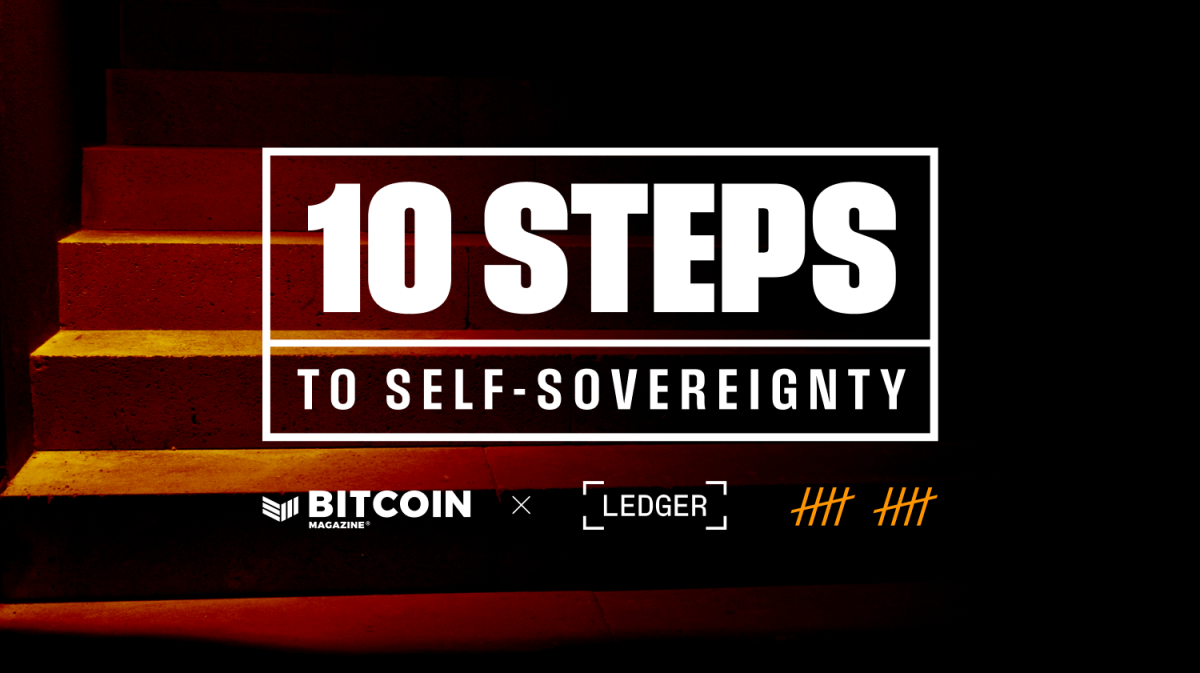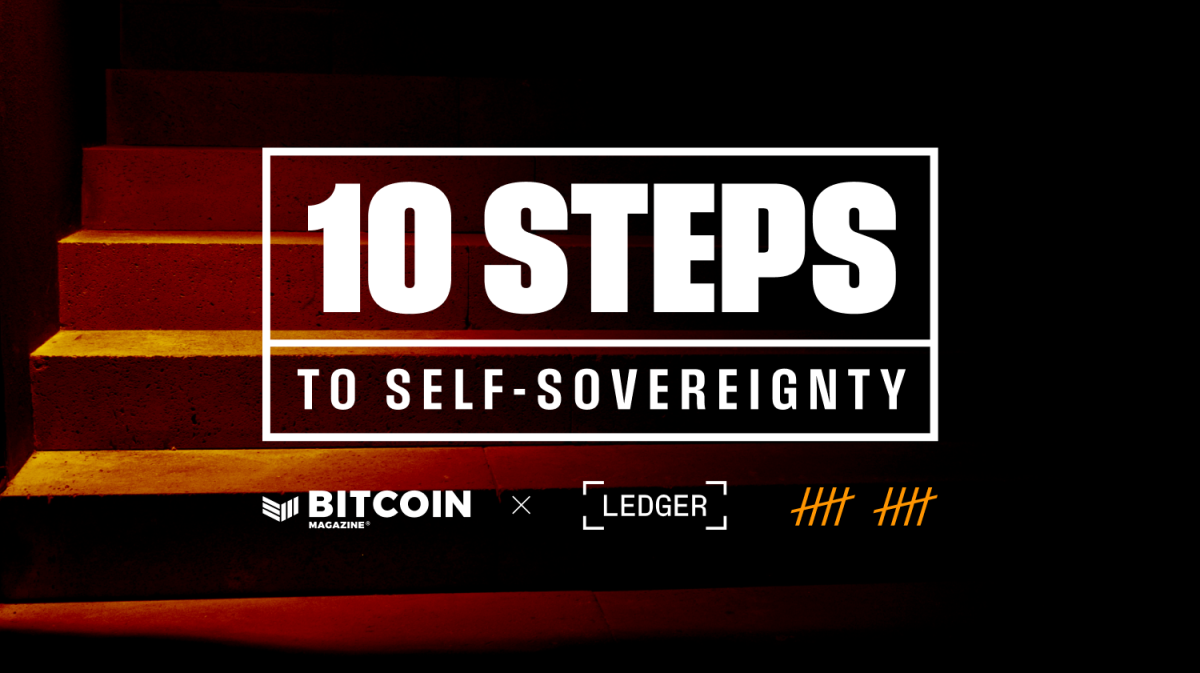Bitcoin
10 Steps to Self-Sovereignty with Bitcoin
Published
4 weeks agoon
By
admin

Bitcoin Magazine’s “10 Steps to Self-Sovereignty” series in partnership with Ledger is officially concluded. Over the last few months we have gone through many different topics, ranging from specific guides on how to manage and interact with your bitcoin securely and in a self-sovereign fashion, to explanations of fundamental properties that make Bitcoin a valuable and functioning asset and network.
Now that the series has concluded, let’s look back at each article and the topic it covered.
Step 1 | Understanding Your Bitcoin Keys: Bip39 Seed Words
This first article takes a look at how to actually manage your seed phrase used to generate your private keys, how they work under the hood, and how to safely generate them. It is absolutely critical that users understand how to manage them properly.
This article gives readers all the basics they need to know.
Step 2 | Bitcoin Has No Top Because Fiat Has No Bottom: Understanding Monetary Debasement
The second article discusses the dynamics of monetary debasement with fiat currencies, and the history of that across different societies. Understanding the abuse of the money printer by central banks and past fiat authorities is an important step to understanding why Bitcoin’s immutable monetary policy makes it so valuable in the world today.
Step 3 | The Do’s and Don’ts of Bitcoin Self-Custody
The next article walks through important milestones and things to ensure you do correctly when managing your funds in Bitcoin. Self custody goes beyond simply generating a seed phrase and putting it in a drawer. When you manage your own bitcoin, the responsibility is entirely yours and no one else’s.
This article walks readers through important things that must be done in managing your own keys, and how to do them correctly.
Step 4 | The Infosec Basics: How To Keep Your Bitcoin Seed Phrase Secure
Generating your seed phrase is step one of self custody, but over time you have to guarantee that it is kept safe from loss and secure from prying eyes and thieves. The fourth article walks readers through how to store their seed phrase backups safely.
Where to store them, where not to store them, the types of materials to store them with, this article covers them all.
Step 5 | Fully Noded: The Basics And Benefits Of Running A Bitcoin Node
The fifth article discusses one of the most important aspects of using Bitcoin aside from managing your own private keys: running a node. It explains why this is important, the network after all only exists because of all the disparate users and businesses who run nodes.
It also explains the direct benefits to you the user gained from running a node and verifying the blockchain yourself.
Step 6 | Quality Money: Bitcoin To Become Scarcer Than Gold Post-Halving
The sixth article compares Bitcoin to it’s analog predecessor: gold. This last halving marked Bitcoin’s inflation rate dropping below that of the king of analog store of value. Gold has always been used a comparison to explain Bitcoin’s properties as money, this article explains why Bitcoin is inherently designed to exceed gold’s value proposition monetarily.
Step 7 | Bitcoin Is Borderless: How Decentralisation and Permissionlessness Grant Autonomy Across Political Jurisdictions
Article seven dissects why Bitcoin is usable all across the world. The network is not concentrated in any single jurisdiction, meaning that it is accessible anywhere in the world. This provides Bitcoin with a unique value proposition in terms of bringing your wealth with you anywhere in the world.
Step 8 | Bitcoin Is Built To Last: How The Network Defends Against Attacks
The eighth article reinforces why Bitcoin is so robust and resilient against failure and attacks. It dissects numerous possible ways the network could be disrupted or attacked, and walks through each scenario to demonstrate why in each of them the likely outcome is that Bitcoin survives and continues to function.
It would take a truly cataclysmic event to bring the Bitcoin network to a halt.
Step 9 | Going Bankless: Bitcoin Offers The Ultimate Financial Freedom
The ninth article looks at one of Bitcoin’s chief value propositions: the ability to spend your money self custodially, without permission from anyone. It looks at both the benefits of Bitcoin that cannot be provided by traditional banks and financial services, as well as the challenges still on the horizon that must be conquered in order to scale these valuable uses to the world.
Step 10 | Running The Self-Sovereign Business
The final article in the series looks at the use of Bitcoin in commerce. Money is meant to be transacted with, and this inherently means that businesses and service providers must accept it in exchange for goods and services. This article looks at the issues that a business must consider when accepting Bitcoin as a form of payment and using it as money in the course of business operations.
Wrapping Up
This series of articles can be a valuable resource for new Bitcoiners looking to enter the space and take full advantage of the sovereignty that Bitcoin has to offer for those willing to take on the responsibility.
Each article is focused on a single topic to either guide readers through the act of custodying their own coins, and ensuring they are equipped to do so safely, or ensure that a well rounded understanding of the value proposition of Bitcoin in a certain area is well understood.
Both of these types of content are valuable and vital in ensuring that Bitcoiners have a sound footing under them when navigating this space. Hopefully all of you have gained some valuable insight from reading them.
For more information on Ledger and self-custody, visit: https://www.ledger.com/
Source link
You may like


The German Government Is Selling More Bitcoin – $28 Million Moves to Exchanges


BC.GAME Announces the Partnership with Leicester City and New $BC Token!


Justin Sun Says TRON Team Designing New Gas-Free Stablecoin Transfer Solution


Mt. Gox is a ‘thorn in Bitcoin’s side,’ analyst says


XRP Eyes Recovery Amid Massive Accumulation, What’s Next?


Germany Moves Another $28 Million in Bitcoin to Bitstamp, Coinbase
Bitcoin
BlackRock’s BUIDL adds over $5m in a week despite market turbulence
Published
8 hours agoon
July 8, 2024By
admin

The Ethereum-based BUIDL fund from the leading asset manager BlackRock has gulped over $5 million in assets over the past week despite the ongoing market turbulence.
Market analytics resource IntoTheBlock (ITB) revealed this in a recent disclosure, stressing that the fund has commanded considerable interest among investors.
While the crypto market struggles, BlackRock’s $BUIDL fund, operating on the Ethereum network, continues to attract new investors.
The fund requires a minimum entry of $5 million, and its total assets have now reached $491 million. pic.twitter.com/Bl19tVVxbW
— IntoTheBlock (@intotheblock) July 8, 2024
Launched in March on Ethereum, the BlackRock USD Institutional Digital Liquidity Fund (BUIDL) marks the company’s first tokenized fund. It allows qualified investors to procure yields in U.S. dollars by subscribing through the fintech company Securitize.
Notably, two months after the fund’s launch, Securitize secured a $47 million funding round from multiple investors, including BlackRock.
The BUIDL fund allocates investments into U.S. Treasury bills, cash, and repurchase agreements. This enables investors to generate yield while maintaining their holdings as tokens on the blockchain. Despite a correlation with the crypto industry, the fund has maintained a positive path amid the ongoing market turmoil.
According to data sourced by ITB, BUIDL now boasts $491 million in assets under management (AUM) amid a sustained growth trajectory. This feat comes as the broader global crypto market lost $290 billion in July, with Bitcoin (BTC) collapsing below $57,000.
On-chain data shows that BUIDL’s AUM stood at $486.46 million as of July 2. Interestingly, this figure has since increased to $491.83 million, recent data confirms. The growth rate indicates an addition of $5.37 million in the last week despite the bearish atmosphere.
With this bullish performance, BUIDL has maintained its position as the largest blockchain-based money market fund. Notably, BUIDL surpassed the BENJI fund from Franklin Templeton to become the largest money market fund in May, when its AUM soared to $375 million.
1/ Blackrock’s BUIDL has surpassed Franklin Templeton’s BENJI (FOBXX) in AUM and became the largest On-Chain Money Market Fund
– BUIDL has grown 36.5% MoM from $274M to $375M
– BENJI only grew 2.1% MoM from $360M to $368M pic.twitter.com/zcMzThfAAh— Tom Wan (@tomwanhh) April 30, 2024
As such, BUIDL has recorded inflows totaling $116.83 million. Meanwhile, BENJI has only seen $33.97 million in capital inflows within the same period.
Source link
Bitcoin
HIVE Digital stock rallies over 9% as Bitcoin miner bolsters crypto reserves to 2.5k BTC
Published
11 hours agoon
July 8, 2024By
admin

Canadian Bitcoin mining company HIVE Digital has released a June financial report, revealing it has increased its reserves to 2,503 BTC stored on the balance sheet.
HIVE Digital Technologies, the Vancouver-based Bitcoin mining company, seems unaffected by the recent miner capitulation that caused Bitcoin (BTC) to plunge below the $56,000 mark.
In a Jul. 8 press release, the company revealed that as of Jul. 7, its crypto holdings on the balance sheet had increased to 2,503 BTC, a more than 2% increase compared to the prior month. In total, HIVE Digital mined 119 BTC in June, keeping the same performance as in May.
Despite recent market turbulence that saw Bitcoin plunge below the $56,000 mark, HIVE Digital appears unaffected. CEO Aydin Kilic addressed the firm’s operational expansion, noting that the remaining batch of Bitmain S21 orders “are ready to ship, and in fact have been upgraded to S21 Pro, representing approximately 1,150 S21 Pro miners from HIVE’s original order in December.” Kilic added that the latest acquisition of 1,000 S21 Pro Miners revealed in May is now “ready to ship,” with the total fleet of new rigs expected to be installed by the end of July.
“Therefore, we expect the total 2,150 pending S21 Pro miners to ship in the next week, bringing HIVE’s total operational hashrate to 5.5 EH/s once fully installed, with a global fleet efficiency of 24.5 J/TH. HIVE expects these machines to be installed before the end of July.”
Aydin Kilic
Following the release of the positive report, HIVE Digital’s shares (HIVE) soared by over 9.5% on Nasdaq, jumping to $3.34, according to data from Google Finance.
HIVE Digital’s reserve boosting comes despite massive capitulation among its rivals. As QCP analysts noted in a research report, Bitcoin miners are showing “signs of capitulation” as the cryptocurrency’s price slid below $56,000 late Jul. 5. Amid the deteriorating landscape, the hashprice mark neared “its all-time low,” a level last seen during the bear market.
Source link
24/7 Cryptocurrency News
Is Ethereum Becoming Scarcer than Bitcoin on Exchanges?
Published
18 hours agoon
July 8, 2024By
admin
Ethereum (ETH) metrics have shown that the digital currency might be suffering from scarcity than earlier projected. According to on-chain data, Ethereum is now being accumulated at a faster rate than Bitcoin.
The Ethereum and Bitcoin Divergence
According to data insights from Leon Waidmann from BTC-Echo, Ethereum is becoming scarcer than Bitcoin. While there are metrics that show the individual performance of BTC and ETH, their correlation per exchange balances is also a crucial one.
🚨HUGE divergence between #Ethereum and #Bitcoin!
ETH is becoming SCARCER than BTC.#ETH Exchange Balance: 10.189% 📉#BTC Exchange Balance: 15.086% 📈
The gap is WIDENING! pic.twitter.com/UnuejbnS8l
— Leon Waidmann | Onchain Insights🔍 (@LeonWaidmann) July 7, 2024
According to the accompanying Glassnode data shared by Waidmann, the current Ethereum exchange balance is pegged at 10.189%. In contrast, that of Bitcoin comes in at 15.08%, a figure that suggests a tightening gap.
Since the conversation around spot Ethereum ETF came into the limelight, demand for ETH has grown. Investors suddenly started buying Ethereum at a frantic pace, accounting for the drain on trading platforms. The investor action is explainable, considering how Wall Street money is projected to buy Ethereum upon ETF launch.
This projection is not unfounded judging by the trend seen in spot Bitcoin ETF products. When the BTC ETF came into the market in January, top firms like Susquehanna International Group (SIG) went all out to buy the asset. The buyups played a crucial role in sending the price of Bitcoin to an All-Time High (ATH) of $73,750.07.
Despite the exchange balance for Ethereum draining fast, the impact on the price of ETH is not visible. At the time of writing, Ethereum is changing hands for $2,983.03, down by 2.31% in the past 24 hours. The coin’s 24-hour low and high trading price comes in at $2,956.99 and $3,080.11 respectively.
Revival Plans for ETH
The future growth of ETH is now hinged on the new long-awaited decision from the US SEC. After it greenlighted the 19b-4 forms for the spot Ethereum ETF application weeks ago, the wait for S-1 is near.
Though the timeline for launch remains largely speculative, the coming 2 weeks appear pivotal. ETF Store President Nate Geraci believes the regulator will do everything it has to do to make Ethereum ETF start trading in 2 weeks.
Read More: Peter Schiff Claims Bitcoin Whales Set Up ETF Investors As “Bag Holders”
Benjamin Godfrey is a blockchain enthusiast and journalists who relish writing about the real life applications of blockchain technology and innovations to drive general acceptance and worldwide integration of the emerging technology. His desires to educate people about cryptocurrencies inspires his contributions to renowned blockchain based media and sites. Benjamin Godfrey is a lover of sports and agriculture. Follow him on Twitter, Linkedin
The presented content may include the personal opinion of the author and is subject to market condition. Do your market research before investing in cryptocurrencies. The author or the publication does not hold any responsibility for your personal financial loss.
Source link

The German Government Is Selling More Bitcoin – $28 Million Moves to Exchanges
BC.GAME Announces the Partnership with Leicester City and New $BC Token!

Justin Sun Says TRON Team Designing New Gas-Free Stablecoin Transfer Solution

Mt. Gox is a ‘thorn in Bitcoin’s side,’ analyst says

XRP Eyes Recovery Amid Massive Accumulation, What’s Next?

Germany Moves Another $28 Million in Bitcoin to Bitstamp, Coinbase

'Asia's MicroStrategy' Metaplanet Buys Another ¥400 Million Worth of Bitcoin

BlackRock’s BUIDL adds over $5m in a week despite market turbulence

Binance To Delist All Spot Pairs Of These Major Crypto

German Government Sill Holds 39,826 BTC, Blockchain Data Show

HIVE Digital stock rallies over 9% as Bitcoin miner bolsters crypto reserves to 2.5k BTC

Pepe Price Analysis Reveals Bullish Strength As Bitcoin Plummets

Taiwan is not in a CBDC rush as central bank lacks timetable

Will SHIB Price Reclaim $0.00003 Mark By July End?

The power of play: Web2 games need web3 stickiness

Bitcoin Dropped Below 2017 All-Time-High but Could Sellers be Getting Exhausted? – Blockchain News, Opinion, TV and Jobs

What does the Coinbase Premium Gap Tell us about Investor Activity? – Blockchain News, Opinion, TV and Jobs
BNM DAO Token Airdrop
A String of 200 ‘Sleeping Bitcoins’ From 2010 Worth $4.27 Million Moved on Friday

NFT Sector Keeps Developing – Number of Unique Ethereum NFT Traders Surged 276% in 2022 – Blockchain News, Opinion, TV and Jobs
New Minting Services

Block News Media Live Stream

SEC’s Chairman Gensler Takes Aggressive Stance on Tokens – Blockchain News, Opinion, TV and Jobs

Friends or Enemies? – Blockchain News, Opinion, TV and Jobs

Enjoy frictionless crypto purchases with Apple Pay and Google Pay | by Jim | @blockchain | Jun, 2022

How Web3 can prevent Hollywood strikes

Block News Media Live Stream

Block News Media Live Stream

Block News Media Live Stream

XRP Explodes With 1,300% Surge In Trading Volume As crypto Exchanges Jump On Board
Trending

 Altcoins2 years ago
Altcoins2 years agoBitcoin Dropped Below 2017 All-Time-High but Could Sellers be Getting Exhausted? – Blockchain News, Opinion, TV and Jobs

 Binance2 years ago
Binance2 years agoWhat does the Coinbase Premium Gap Tell us about Investor Activity? – Blockchain News, Opinion, TV and Jobs
- Uncategorized3 years ago
BNM DAO Token Airdrop

 Bitcoin miners2 years ago
Bitcoin miners2 years agoA String of 200 ‘Sleeping Bitcoins’ From 2010 Worth $4.27 Million Moved on Friday

 BTC1 year ago
BTC1 year agoNFT Sector Keeps Developing – Number of Unique Ethereum NFT Traders Surged 276% in 2022 – Blockchain News, Opinion, TV and Jobs
- Uncategorized3 years ago
New Minting Services

 Video2 years ago
Video2 years agoBlock News Media Live Stream

 Bitcoin1 year ago
Bitcoin1 year agoSEC’s Chairman Gensler Takes Aggressive Stance on Tokens – Blockchain News, Opinion, TV and Jobs


✓ Share: